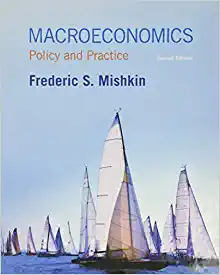Question
Consider the Williamson model for horizontal mergers that we discussed in class. Sup pose that demand is given by P 200-Q and that prior to
Consider the Williamson model for horizontal mergers that we discussed in class. Sup pose that demand is given by P 200-Q and that prior to the merger, average costs were ACo = 100. The pre-merger price is Po= 120. After the merger, average costs go down to AC = 80, but prices increase to P = 160.
(a) Was the market initially competitive? Why or why not? (b) Plot a graph of the Williamson model with the given parameters. Label all curves axes and intercepts (c) Do the firms find the merger profitable? Why or why not?
(d) How much total surplus is lost from the merger? How much total surplus is gained from the merger? (e) Does the merger satisfy the compensation principle? Why or why not?
answer all questions
Collect monthly prices for 7 (seven) stocks/assets of your choice for the last 10 (ten) years traded in a market (of your choice). Use the data to construct one portfolio (i.e. same stocks/assets). However, use it to generate three objectives/scenarios the first is to maximise returns, the second is to minimise risk and the third is to maximise sharp ratio. Use the Excel solver to optimise the portfolio weights and the constraint option so no asset should have zero weight - No short-selling is allowed (No negative weights). Report the annualised expected returns and risks of the three objectives/scenarios and any other necessary performance indicators. Report the weighted average portfolio-beta for each objective/scenario. Use available data that can be easily obtained online. Use dividend adjusted close prices
Section 1:
1. Utilise your knowledge of the underlying theories, assumptions and limitations of various asset pricing models including and not limited to: Capital Asset Pricing Model (CAPM); Arbitrage Pricing Theory (APT); Multifactor Models etc.
2. Utilise argument and findings from the recent development in the literature to support your discussions.
1. Use the knowledge gained from Transferable Skills documents on blackboard namely Portfolio and CAPM. These two documents and accompanied Excel files will help guide you to optimise portfolio weights and estimate assets' beta using CAPM or Market model by employing regression analysis and other functions in Excel.
2. Calculate each stock variance and standard deviation using Excel
3. Use the SOLVER functions in Excel to maximise (minimise) portfolio return and sharp ratio (risk)
Suppose that you want to invest in a small pizza shop near campus. Your research suggest that the profitability of your store depends on the local economy. There are 4 possible economic conditions: {boom, normal, recession, crisis}. Your estimation on the probability distribution of these 4 conditions is {0.2, 0.2, 0.35, 0.05 } respectively. Your estimation on the profitability of your store is {10%, 5%, 0%, -20% } respectively. Please answer the following questions. 1. What is the expected return of your investment? 2. What is the magnitude of risk measured by the standard deviation of your return? 3. Suppose that you evaluate risk and return according to the following model: E(R) A 2 Var(R) where R is the random return of your investment. A is a constant which measures how risk averse you are. a Suppose A = 1 and the risk free return is 0.5%. Would you like to invest in the store? b Suppose that A = 5 and the risk free return is 0.5%. Would you like to invest in the store? c Suppose that A = 1 and the risk free return is 1%. Would you like to invest in the store?
Assume the existence of a two-period Diamond Model. Individuals may live for up to two periods t and t + 1. All individuals both live and work in period t. Some proportion of individuals die at the end of the first period, and do not consume in the second period. The remaining proportion (1 ) will will live and consume in period 2. Expected lifetime utility is given by: 2 U(C1t , C2t+1) = ln(C1t) + (1 )ln(C2t+1) It is assumed that there is no discount factor and that individual's value second period consumption as much as they value first period consumption. The lifetime budget constraint, which is not directly effected by the possibility of death, is given by: C1t + C2t+1 1+rt+1 = wt 1 + rt+1 and wt denote the marginal products of capital and labour respectively. The production function in this economy is given by Yt = K t L. L denotes a fixed quantity of labour. That is, there is no population growth in the model. We assume that At = 1, and there is no growth in the state of technology. a) Solve for the optimal values of C1t and C2t+1 (4 pts). b) Find the optimal savings rate s in this economy. (2 pts) c) Assume that there is 100% capital depreciation from one year to the next, and next year's capital stock is simply this years investment. Solve for the steady state level of capital and output, denoted by K and Y (4 pts). d) Solve for the steady state levels of wt , 1 + rt+1, C1t ,C2t+1, and denote your solutions by w ,1 + r ,C 1 , and C 2 respectively (12 pts) e)Using your results from d), find C 2 . f) Is your result from e) positive, negative, zero, or are we able to tell? Explain the intuition behind this finding.
Step by Step Solution
There are 3 Steps involved in it
Step: 1

Get Instant Access to Expert-Tailored Solutions
See step-by-step solutions with expert insights and AI powered tools for academic success
Step: 2

Step: 3

Ace Your Homework with AI
Get the answers you need in no time with our AI-driven, step-by-step assistance
Get Started


